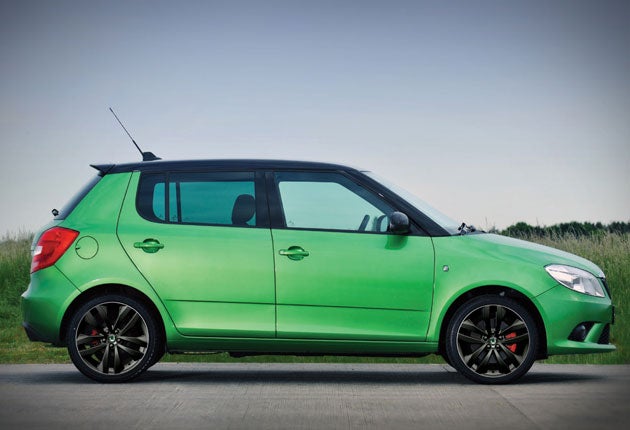Skoda Fabia vRS
It has Volkswagen's best engine under the bonnet – but power isn't everything

A properly sporting Skoda. Why not? The Fabia S2000 rally car flies through the forests to great effect, and the Octavia vRS has built itself a cult following among those who enjoy its Golf GTI-like driving qualities dressed down in a visually unlikely package.
Max respect for the Octavia vRS, then. Here we are testing its newly-created small sibling, the Fabia vRS. There was a car of that name in the previous-shape Fabia range, a car with the unlikely but effective feature of a muscular diesel engine. Capable as that rapid Skoda was, it caught few imaginations. A diesel engine in such a car just isn't sexy.
There's no such problem with the new one. It uses the engine which has steamrollered the motor industry's Engine of the Year awards for several years now (I know – I'm on the judging panel), which is the Volkswagen group's 1.4-litre TSI unit. It's the original TSI, and the only engine for which the initials actually make sense because it uses both a supercharger and a turbocharger.
So it's expensive to make but very effective, the supercharger providing powerful boost at low engine speeds, the turbocharger taking over as engine speed rises and the supercharger is decoupled.
In the Fabia the engine appears in its most potent guise, the 180bhp rating also used for the most sporting Seat Ibiza (the Cupra), the imminent Volkswagen Polo GTI, and soon the warmed-over Audi A1. All these cars are related under the skin, and all have the single transmission choice of a seven-speed, double-clutch, sequential transmission.
Also obligatory with this lusty engine is some form of suspension and visual makeover. So the vRS is lowered by 20mm and tautened by firmer settings for the dampers, stiffer rubber bushes and rear springs. The wheels are 17in in diameter, the brakes use a larger master cylinder to reduce the pedal's travel. Spoilers, valances and racier seats complete the package, and it's all discreetly done in the way that has worked so well for the Octavia vRS.
It sounds tempting, especially as at £15,700, the vRS undercuts all its rivals. It looks neatly purposeful for its task, and its eager pace is obvious from the start. Given its head, the vRS will reach 62mph in 7.3 seconds and keep going in its seventh gear right up to 139mph. And there's even an estate-car version if you really want to nibble the edge of the oxymoron envelope.
The vRS scoots around corners as you would expect, except that the front wheels don't drift wide as you pour on the ample power because a clever system (called XDS) lightly brakes the inside front wheel should that drift or, worse, thrust-dissipating wheelspin threaten to intervene. Turning the stability system off unleashes the wheelspin in torrents.
There are snags, though. One is minor: the firm suspension and low-profile tyres transmit a lot of road noise on coarse surfaces, although the vRS actually absorbs bumps quite well. Another is that the steering is too slow to respond, demanding big steering-wheel movements before much happens. The worst, however, is the reason I could never love this car, because it spoils one of the aspects of driving I most enjoy. It's that double-clutch gearbox, which is supposed to make us feel like racing or rally drivers, but which actually shuts off a whole layer of subtle interaction.
For a start, it has a needlessly low first gear so you have to change up even while you are emerging from a junction. And that means fumbling around the steering wheel, already turned more than it should be, because the paddle-shifters are attached to it. Yes, you could prod the central lever instead but that's another thing to remember.
Or you could just put it in automatic and forget the whole idea, which you might do anyway because the gearshift is too slow to make you feel properly involved in the process. Besides which there are too many gears, especially for an engine with such a broad spread of pulling power.
Skoda Fabia vRS. Good in parts, spoilt by a transmission which will disqualify it for a significant number of enthusiast car buyers. The real reason it's there, according to an Audi engineer, is that the VW group has no manual gearbox able both to fit that engine and handle its output. Memo to engineers: find one, quickly.
The rivals...
Citroën DS3 Sport £15,900.
Most convincing sporting hatchback from this group in years. Handsome, well made, punchy 156bhp turbo engine, handles with real panache.
Mini Cooper S from £17,640.
Almost default choice for quick, small car, with more frugal, more powerful (183bhp) version of engine in DS3. Great fun, not much space, strong image.
Seat Ibiza Cupra £17,020.
Almost the same as the Fabia under its Spanish skin, a more entertaining handling balance in bends, same transmission, inexplicably higher price.
Subscribe to Independent Premium to bookmark this article
Want to bookmark your favourite articles and stories to read or reference later? Start your Independent Premium subscription today.

Join our commenting forum
Join thought-provoking conversations, follow other Independent readers and see their replies